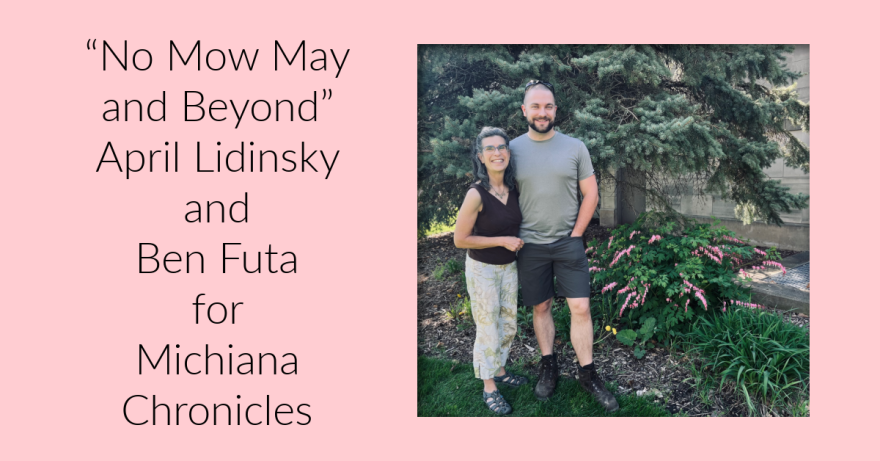I’m April Lidinsky
And I’m Benjamin Futa
April: Thank you so much for taking time to talk with me today. We know one another from the hallways of IU South Bend, when you were studying Sustainability here; we community-gardened together for a season, and now I am so grateful to be a customer at The Botany Shop. I wanted to talk with you about this initiative, “No Mow May.” So, if you would talk a little bit about the origins, and what it means in the U.S., that would be great.”
Ben: I first discovered “No Mow May” in early 2020, right in the early moments of lockdown, when I was managing a public garden on UW Madison’s campus. That was my previous job before coming back to South Bend. It worked really great for us, because everything was locked down, and we had minimal staffing, and we thought, “Great! One less thing we have to do. We won’t mow this month!”
The origins come from the UK; that’s where this movement really started. The idea is to allow our lawns to go wild for a brief moment of time, really to support spring pollinators as they’re coming out of hibernation: They need nectar, they need pollen, and we allow those things that grow with our grass to bloom naturally.
April: And it’s come to the US: I think maybe Wisconsin is the state that has been a leader in this?
Ben: Again, I first saw it in 2020, but this year it really seems to to just be sort of everywhere. So, it took a couple of years, but I’m seeing it pop up in multiple places right now.
April: So, how could somebody who is interested in this participate without it looking like we’re just being bad home owners? Do you have some ideas about how to make this look intentional?
Ben: Yeah, and you really hit the nail on the head. The key is intentionality. So, we don’t want this to look neglected; we want it to look purposeful. One design tip that I really enjoy is “framing.” So, think about a picture you hang on your wall That’s a piece of art; that’s something that was meant to be there, that has an intention. And so, if we can keep a border mowed along our long, and even if we’re leaving the rest of it to go wild — especially if that border goes along a sidewalk, or a driveway, or an area that people frequent — that will be a clue for people that, “Hey, wait — if they’re mowing this, why aren’t they mowing that?” That promotes people asking “Why?” rather than reacting negatively, and saying, “Oh, they must have just given up.”
April: I appreciate the fact that you see this as an educational opportunity. I have read that there’s some nuance to this. The idea is not simply to let a chemical lawn grow wild, but, rather, to shift our perspective to more native plants. So, could you talk a little be about choices that homeowners could make to shift our monoculture lawns to something that goes far beyond No Mow May? What are some of the options?
Ben: I think of No Mow May as an on-ramp. This is a moment to help us get on a new trajectory toward more sustainable landscapes. But it certainly isn’t the be-all-end-all. It’s meant to raise awareness, to start conversations like we’re having today, but don’t think of it as the end of the road, think of it as the beginning of this journey. It’s important to realize, especially if you’ve had a conventional lawn, with chemicals and weed treatments, that that’s not a great system to begin with. Just stopping that for a month isn’t going to make a huge impact.
Really, what we can do is just back off all those chemicals entirely. Focus on organic lawn care, so really think about building a healthy soil ecosystem, through aeration, proper watering, adding organic nutrients into the soil, instead of just stringing them along on nitrogen fertilizers, which really isn’t great for the grass, it’s not great for our waterways, our soil webs.
Of course, beyond the lawn, you can transition to an electric mower, a reel mower to reduce noise emissions, reduce carbon emissions. I like to say: Burn calories, not carbon! That’s the beauty. And of course, you can always remove chunks of your lawn entirely. Replace them with native plants, Do some research; find out what plants grow really well for us in this area … and the good news is, you’ll never have to mow again.
April: That’s wonderful. Is there one kind of low-growing plant you’d suggest that might be a good gateway?
Ben: Oh, there are so many, and it really depends upon your preferences as a homeowner. There’s everything from low-mow fescue, which is a grass replacement; it looks like conventional lawn turf but only needs to be mown a couple times a year. Or, all the way through to a tapestry lawn, that are low-growing ground covers that flower. And, of course, just actual native plant gardens.
April: Fabulous. Well, you are such a great resource in our community. Thank you for getting us started on this conversation. More to come!
For Michiana Chronicles, I am April Lidinsky
Ben: And I am Ben Futa
Music: "Good as Hell" by Lizzo



